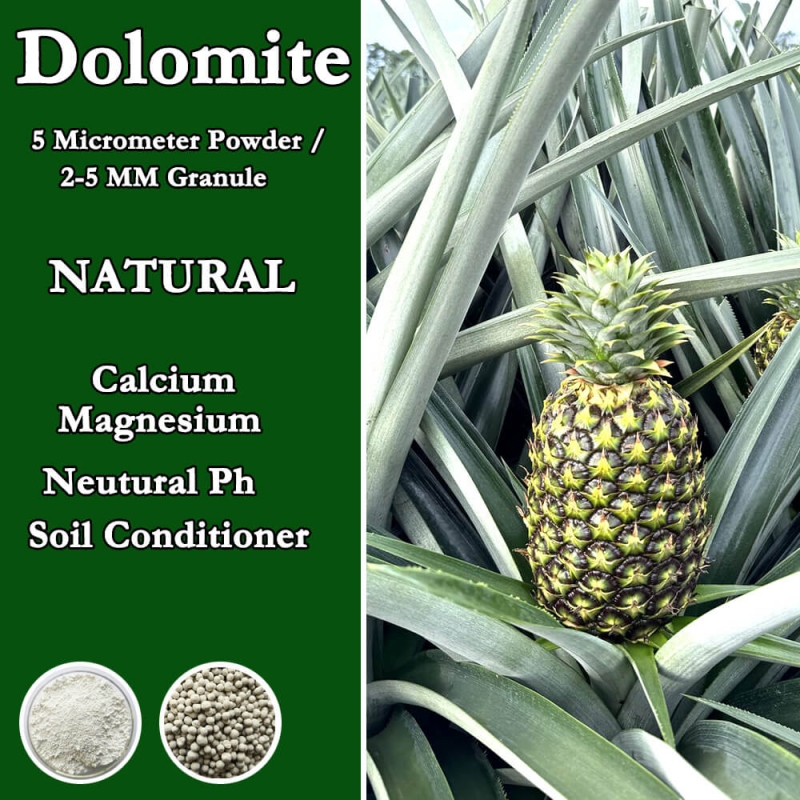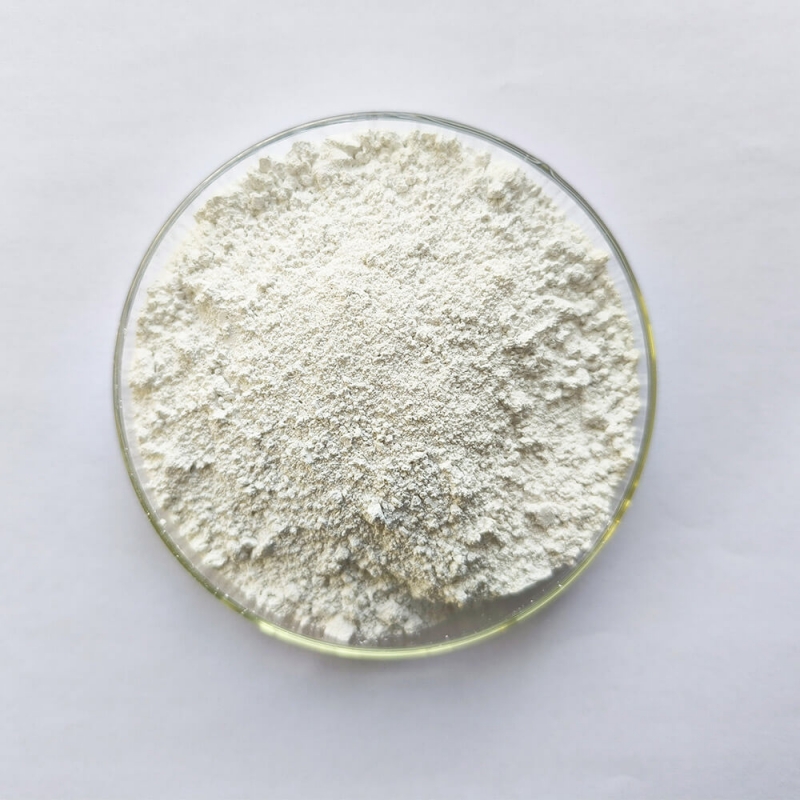




CaO:30%
MgO:20%
Particle Size:D 50,2500 mesh (5um)
Granule Size:95% (2-5MM)
Density:1.254 g/cm3
Appearance:White powder or White granule
Odor:No odor
Package:25kg, 1000kg
Country of Origin:China
MOQ:60,000Kgs
Producing Capacity:1200,000Kgs monthly
Derived From:100% Mineral Dolomite
Agriculture Lime Dolomite,Calcium & Magnesium Soil pH Regulator
Adjusting Soil pH, dolomite can play a role in neutralizing acidity. Its main components, calcium carbonate and magnesium carbonate, can react with hydrogen ions in the soil.
Dolomite contains nutrients such as calcium and magnesium. Calcium is an important component of plant cell wall
which can strengthen the mechanical strength of plant organs such as stems and leaves.
Magnesium is a core component of chlorophyll. Plants absorb magnesium ions to synthesize chlorophyll.
Dolomite can improve the granular structure of the soil. It can aggregate soil particles together,
increasing the air permeability and water permeability of the soil.
Dolomite has a certain adsorption capacity and can adsorb heavy metal ions such as cadmium, lead, and mercury in the soil.
Its adsorption mechanism mainly includes surface adsorption and ion exchange.
When dolomite is used to adjust soil pH and improve soil structure, it helps to improve the soil's ability to retain nutrients.
What's Agriculture Lime Dolomite
Dolomite is a carbonate mineral with a chemical composition of CaMg(CO₃)₂. In warm and clear shallow seas,
seawater rich in magnesium ions interacts with calcium carbonate sediments.
After a long period of time of sedimentation, compaction, and recrystallization, dolomite is finally formed.
Guaranteed Analysis
CaO----------------------------------------30%
MgO---------------------------------------20%
Particle Size -------------------------------2500 mesh (5um)
Granule Size (2-5 mm )--------------------95%
Density------------------------------------1.254 g/cm3
Directions For Use
Before using dolomite for soil improvement, it is essential to test the soil first. Analyze indicators such as soil acidity and alkalinity (pH value), calcium and magnesium content.
Base fertilizer application:
It is best to use dolomite as a base fertilizer before planting. Usually, it is carried out after the autumn harvest of crops or before spring sowing.
The application amount can be determined according to the soil test results and the needs of the planted crop, generally around 1500 - 7500 kg per Hector.
Topdressing:
During the growth of crops, if changes in soil acidity and alkalinity are detected or if the crops show symptoms of calcium or magnesium deficiency,
topdressing can also be carried out. Generally, the amount per hector does not exceed 7500 kg each time
Determination of application amount
Based on soil testing: Before using dolomite for soil improvement, it is essential to test the soil first. Analyze indicators such as soil acidity and alkalinity (pH value),
calcium and magnesium content. For example, if the soil pH is between 4.5 and 5.5, which indicates highly acidic soil with low calcium and magnesium content,
depending on the soil texture and crop requirements, the application rate of dolomite may be around 100 - 200 kg per mu. For sandy soil,
due to its relatively weak buffering capacity, the single application amount may need to be appropriately reduced, but the number of applications increased;
while for clay soil, the single application amount can be appropriately increased.
Considering crop needs: Different crops have quite different requirements for soil acidity and alkalinity as well as calcium and magnesium nutrition.
For instance, blueberries grow well in acidic soil (pH 4.0 - 5.5) and generally do not require dolomite to raise the soil pH. However,
most vegetables like Chinese cabbage and radishes grow optimally in soil with a pH value of 6.0 - 7.5. For acidic soil, more dolomite is needed to adjust the pH.
Cruciferous vegetables have a relatively high demand for calcium. When growing these types of vegetables,
the application amount of dolomite can be appropriately increased to meet their calcium needs.
Selection of application time
Base fertilizer application: It is best to use dolomite as a base fertilizer before planting. Usually, it is carried out after the autumn harvest of crops or before spring sowing.
For example, when planting wheat, after harvesting the previous crop like corn in the fall, deeply plow the land, then evenly spread the dolomite powder on the soil surface,
and turn it into the lower soil layer with deep plowing.
This allows the dolomite enough time to fully contact the soil particles and play its roles in regulating acidity and alkalinity and improving soil structure.
The application amount can be determined according to the soil test results and the needs of the planted crop, generally around 100 - 150 kg per 666 square meters.
Topdressing: During the growth of crops, if changes in soil acidity and alkalinity are detected or if the crops show symptoms of calcium or magnesium deficiency,
topdressing can also be carried out. For example, when the leaves of citrus trees turn yellow during growth (which may be a symptom of magnesium deficiency),
a shallow ditch can be dug under the drip line of the tree crown, and an appropriate amount of dolomite powder can be sprinkled into the ditch and then covered with soil.
However, the amount of dolomite used for topdressing should be relatively small to avoid adverse effects on the crop roots. Generally, the amount per mu does not exceed 50 kg each time.
Application methods
Broadcast application: This is the most common method. Evenly spread dolomite granules or powder on the soil surface, and then incorporate it into the soil through plowing, harrowing, etc.
For large areas of farmland or orchards, using mechanical spreaders can improve efficiency. For example, in paddy fields for rice cultivation, during the fallow period or before planting,
an agricultural fertilizer spreader can be used to evenly spread dolomite powder on the field surface, and then the field is plowed so that the dolomite is fully mixed with the soil to
a depth of about 15 - 20 cm, which can effectively improve the overall properties of the soil.
Row or hole application: For some crops with high planting density or under special topographic conditions such as on hillside fields, row or hole application can be adopted.
For example, when planting grapes, dig strip-shaped ditches on both sides of the grape plants and put dolomite into the ditches, and then cover with soil.
Or when planting fruit trees, put an appropriate amount of dolomite at the bottom of the planting holes.
This method can supply dolomite more concentratedly to the soil around the crop roots and improve its utilization rate.
However, when using row or hole application, care should be taken to avoid direct contact between dolomite and crop roots,
so as not to cause damage to the roots due to excessive local concentration.
© Copyright - 2021 | All Right Reserved. Designed By rutombio.com